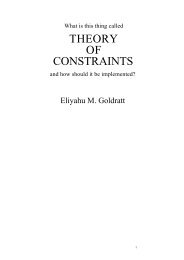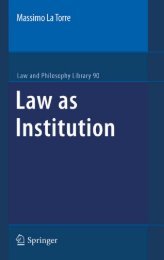Making of a German Constitution : a Slow Revolution
Making of a German Constitution : a Slow Revolution
Making of a German Constitution : a Slow Revolution
Create successful ePaper yourself
Turn your PDF publications into a flip-book with our unique Google optimized e-Paper software.
144 • The <strong>Making</strong> <strong>of</strong> a <strong>German</strong> <strong>Constitution</strong>the judiciary independence and dividing the courts into regional and local courts. 80This provision, as well as others, had been expressed in the constitutional document<strong>of</strong> 1849. Its Article 175 stated: ‘The courts shall exercise their judicial powersindependently.’ 81 At the same time, the Gerichtsverfassung dismantled Saxony’s judicialbureaucracy by abolishing, altogether, the old Patrimonialgerichte (patrimonialcourts). 82 In this way, it annulled an important seigniorial privilege and vestedcitizens with the basic right to a hearing before an impartial judiciary. Again, provisionsfor the abolition <strong>of</strong> patrimonial courts were contained in the 1849 constitutiondocument. Article 174 stated: ‘All jurisdiction emanates from the State. There shallbe no patrimonial courts’. 83Following the introduction <strong>of</strong> the Gerichtsverfassung, the Strafprozeßordnung(1855) was introduced in Saxony, which secured more basic rights for ordinarycitizens. Like Hanover’s procedural legislation, it made trial procedure public andoral, and it awarded citizens the right to independent counsel. 84 Courts became thecentre <strong>of</strong> adjudication and, increasingly, safeguarded common men against arbitraryjustice in criminal cases. In addition, the institution <strong>of</strong> the Kollegialgericht (panel<strong>of</strong> judges) <strong>of</strong>fered a safeguard against arbitrary judgement. 85 While I have only discussedthe procedural reforms in Hanover and Saxony, procedural legislation wasalso enacted in Oldenburg (1857), Baden (1862), Württemberg (1868) and Bavaria(1869). From 1850 onward, the number <strong>of</strong> lay judges, jury courts, commercial courtsand trade tribunals increased steadily in Central Europe. 86The aim <strong>of</strong> procedural legislation was to subject the whole society to the samelaws and to draw down any legal distinctions between the bourgeoisie and hereditaryaristocracy. In addition to delineating court procedures, procedural codes organizedthe court system, the constitution <strong>of</strong> which was crucial to the ability <strong>of</strong> liberalsto implement and enforce legislative revolution and liberal rule in their envisionedGemeinwesen. Procedural reform also increased the number <strong>of</strong> courts. In this manner,it expanded the reach and the authority <strong>of</strong> a new apparatus <strong>of</strong> liberal socialcontrol. It gave liberals the means to secure that the people’s behavior conformedto liberal sociopolitical standards and gave them the means to exert disciplinarycontrol in the case <strong>of</strong> infraction. This expanding arm <strong>of</strong> the emerging civil society,increasingly, exerted control over ordinary private matters, such as the registration<strong>of</strong> births, deaths and marital relations. Every individual increasingly fell within theliberal state’s purview and within reach <strong>of</strong> its disciplinary authority. The courts andlaws increasingly replaced the old structures and slowly emerged as the institutionalbackbone <strong>of</strong> private and public life.The New PeriodicalsA strong indicator <strong>of</strong> the advance <strong>of</strong> constitutional transformation was not only thefounding <strong>of</strong> new law journals, but the changing nature <strong>of</strong> these journals. Where the




